THURSDAY
MAY 31 - 2018
Millpond
News
There is
little in the way of news from the Hermitage
Millponds. It is no longer possible to see the Mute
Swan nest on Peter Pond as it is well hidden in the
reedbeds. However, the presence of the cob swan alone
on the pond suggests the pen is still sitting.
Over on Slipper
Millpond the Coots appear to have given up trying to
raise a family on the north raft; the two Coots were
on the water with no activity at the nest.
I could see an adult Great Black-backed Gull with
just one chick on the south raft, though other
chicks could have been hidden in the vegetation. There
were three chicks when I last saw the raft a couple of
weeks ago. Hmm ...
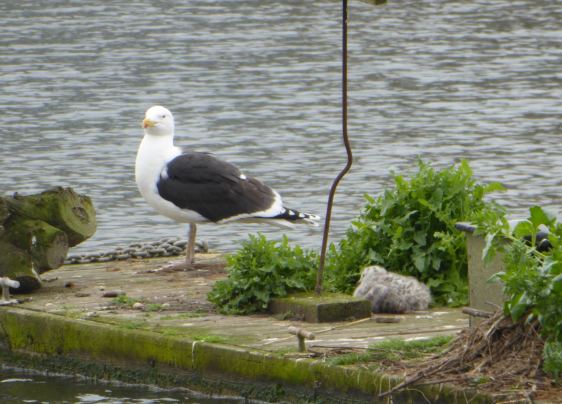
It was good to see
Hemlock and Tree Mallow in full flower
on the east side of Slipper Millpond.
Brook
Meadow
On the way
home I stayed on the raised path by the river as the
grassland was very wet after heavy showers, but there
was plenty to see and admire as always. The avenue of
Cow Parsley along the main river path has been
replaced by a cascade of grasses which you brush
against as you walk along.
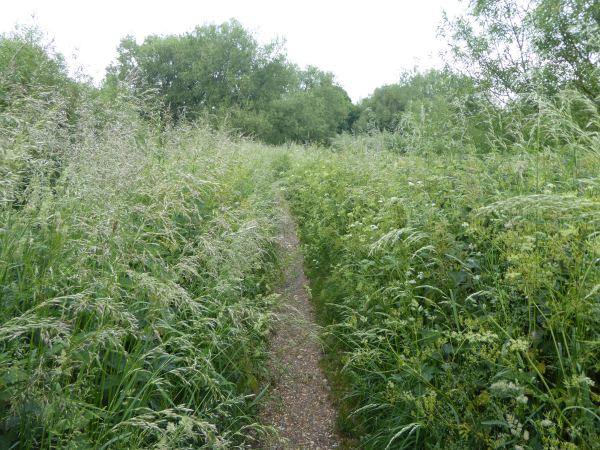
The massive leaves of
Butterbur are like giants rising from the
ground, impressive and eerie.
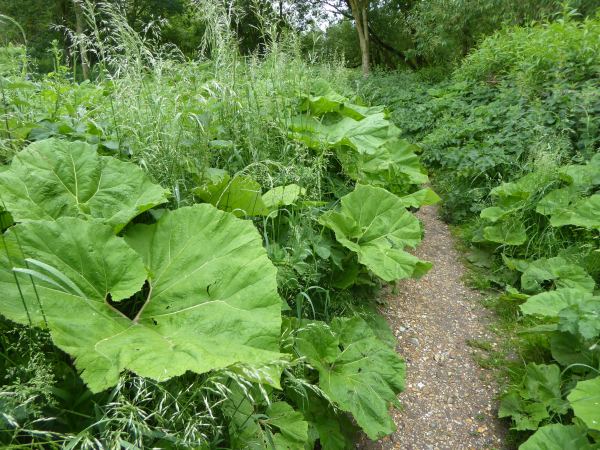
It was a joy to hear
the scratchy song of a Whitethroat singing from a
bramble bush near the path.
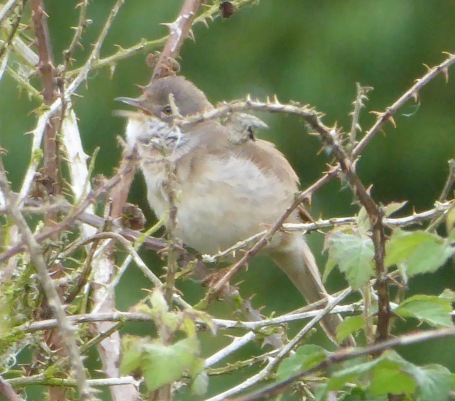
Here is a short video
clip I made of the Whitethroat . . . https://youtu.be/_QDW_qIH198
WEDNESDAY
MAY 30 - 2018
Orchids
galore
We have record
numbers of orchids on Brook Meadow this year! This
afternoon, I counted 102 Southern Marsh Orchids of
which 90 were on the north meadow (some outside the
twig barrier) and 11 on the Lumley area, plus another
one on the main centre meadow. I have marked most of
the flowering spikes with sticks, though many are
gradually being overtaken by the burgeoning bindweed
and other natural vegetation. Here is a nice one that
I cleared a bit.

As shown in the
following chart this year's count of Southern Marsh
Orchids represents a significant jump from the
previous high of 36 last year. At least we are
starting to approach the 500 plus that are regularly
found on Fishbourne Meadows, though we are way behind
Southmoor, Langstone where counts are in the
thousands!
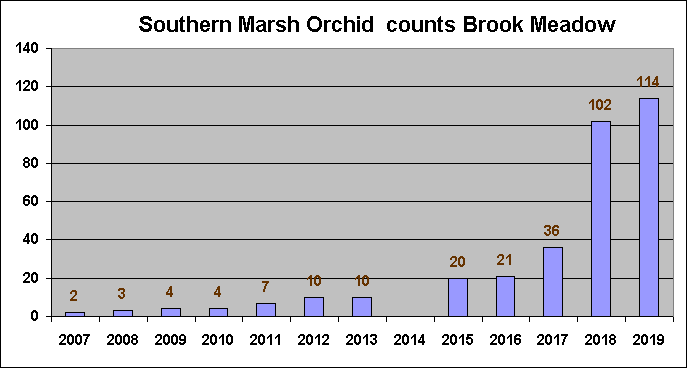
I also counted a total
of 24 Common Spotted Orchids, including 13 on
the main orchid area and 11 on the Lumley area. These
flower spikes tend to be much paler in colour than the
Southern Marsh Orchids.
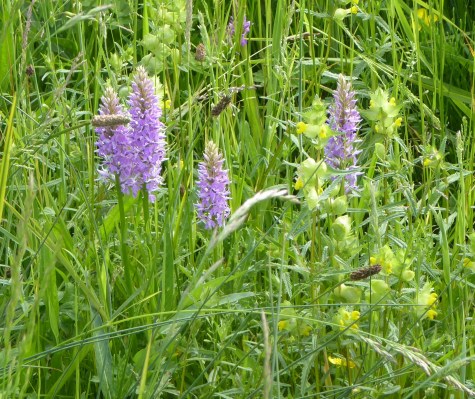
However, I did find
one orchid all on its own with a darker flower spike.
It looked a bit like a Southern Marsh Orchid though it
had the spotted leaves of a Common Spotted Orchid.
Maybe it is a hybrid? I have marked it with a stick.

I looked hard for any
sign of Bee Orchids, but without any success.
The vegetation is so lush this year that it is going
to be difficult to find any.
The Ragged
Robin is still looking good on the Lumley area and
centre meadow, but is starting to go over. The count
of 433 flowering plants I did on May 22 will be the
final one for this year.
One extra flower I did
not expect to find was Smooth Tare on the
centre meadow close to the main cross path at Grid
Ref: SU 75115 06039. This is the first example of
Smooth Tare that I have found on the Brook Meadow
site, except for a regular crop on the Lillywhite's
patch adjacent to the south meadow. I have marked it
with a stick.

Distinguished from
Hairy Tare - it is hairless with fewer longer leaflets
(3-6) and unequal sepal teeth. The hairless pods had
no seeds, so I was not able to check the number of
seeds - Smooth Tare would be downy with four seeds. I
shall have another look at it in a week or so to make
doubly sure.
Finally, here is the
male Beautiful Demoiselle that kept me company
while on the orchid area. What a lovely creature.
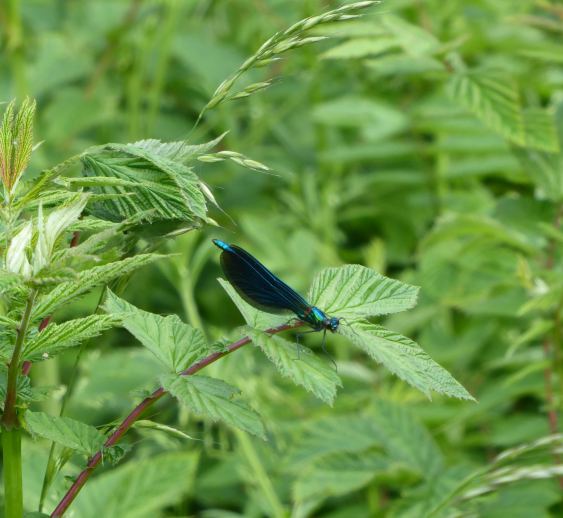
SATURDAY
MAY 26 - 2018
Longhorn
Beetle
The Havant
Wildlife Group had their Saturday walk on Old
Winchester Hill. They saw lots of interesting stuff
including this rather splendid Longhorn Beetle which I
think could by the extravagantly named Golden-bloomed
Grey Longhorn Beetle (Agapanthia
villosoviridescens). Any other offers?

See the special Havant
Wildlife Group page for the full report at . . .
http://familyfellows.com/hwg-walk-reports-2018.htm
FRIDAY
MAY 25 - 2018
Langstone
Mill Pond
Peter
Milinets-Raby visited Langstone Mill Pond this
afternoon as the tide was falling (from 12:30pm).
Off shore: 2 Shelduck, An amazing 5 Great Crested
Grebes together, 3 Common Tern, 1 Sandwich Tern, 10
Med Gulls over.
Pond: Mallard with 4 ducklings still present, plus
another female with seven ducklings. Tufted Duck pair
(see photo).
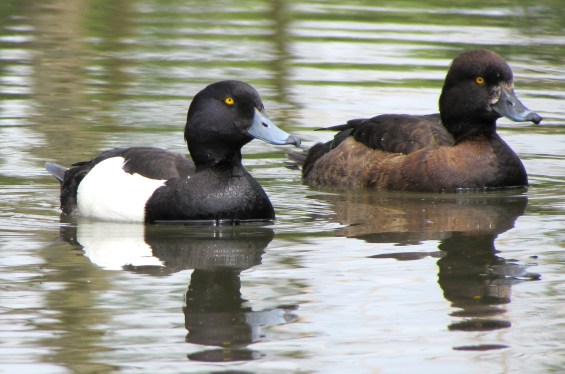
3 Reed Warblers,
Cetti's Warbler heard, Chiffchaff and Blackcap both
singing. There are 4 Little Egrets nests that are
viewable and have tiny chicks.
Latest Update
to the Grey Heron colony - see photo:

Nest 1: Re-sitting for
second brood and possible tiny chicks?
Nest 7: Has three
young
Nest 8: Has one
young
Nest 10: Two
young.
Nest 11: Has two
young
Nest 12: To the rear
of nest 8, has three young.
Nest 6 was not used,
so a total of 11 pairs this year.
THURSDAY
MAY 24 - 2018
Asian
hornet - Vespa velutina
John
Cabell reports that his neighbours in North Emsworth
have had to eject large Hornets from their living
room, having presumably entered by the open door from
the garden. They were found crawling across the carpet
and were easy to snare into a jar but then went into a
frenzy. The neighbours say these Hornets are much
darker than the Common Hornets that they very
occasionally see in the garden, which look more like a
large common wasps in bright yellow and black.
Having read on the internet about the invasion of
Asian hornets to the detriment of our resident Honey
Bee population John wonders if these Hornets could be
Asian and, if so what should be done about them.
Here is John's
photo of one of the Hornets kept in a jar for two days
and still alive.
I did a quick check of
images of Asian Hornets on the internet and John's
Hornets certainly could be the Asian variety, though
it is not easy to tell from the photos. Here are some
internet photos of Common and Asian Hornets side by
side for comparison. The Asian is on the right.
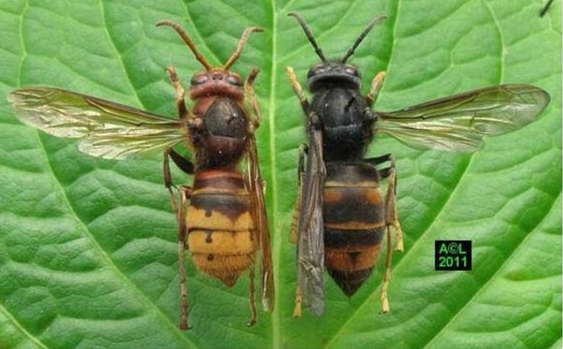
Asian hornet is an
invasive non-native species from Asia which arrived in
France in 2004 where it spread rapidly. As a highly
effective predator of insects, including honey bees
and other beneficial species, it can cause significant
losses to bee colonies, and potentially other native
species.
It was detected for the first time in GB in Tetbury,
Gloucestershire in September 2016. A single nest was
found and eradicated and no subsequent sightings have
been made in the area. A further sighting was made in
Woolacombe, Devon, in September 2017. A single nest
was located and destroyed. A sighting was made in
April 2018, more information here . . .
https://www.gov.uk/government/news/asian-hornet-identified-in-lancashire
Clearly, it is
important to report any suspected sightings of this
species as soon as possible. Vigilance is particularly
required in southern parts of England and the areas
where other sightings have been made. The Asian hornet
is active mainly between April and November (peak
August/September) and is inactive over the winter.
Here is an official web site with an online form to
report sightings . . . http://www.brc.ac.uk/risc/alert.php?species=asian_hornet
I have suggested to
John that either he or his neighbour report the
Hornets and send the photos. If anyone else has seen
or heard about these Hornets locally I would be
interested to hear from them.
TUESDAY
MAY 22 - 2018
Southern
Marsh Orchids
I went over to
the meadow this morning to do another count of the
Southern Marsh Orchids. Starting at the main orchid
area on the north meadow I counted a total of 27
flowering orchids, including several new ones that I
did not see yesterday, so they are coming up daily.
The flower spikes are all fairly small and should
double their present size at least by the end of the
growing season. This is what they should look like
soon.
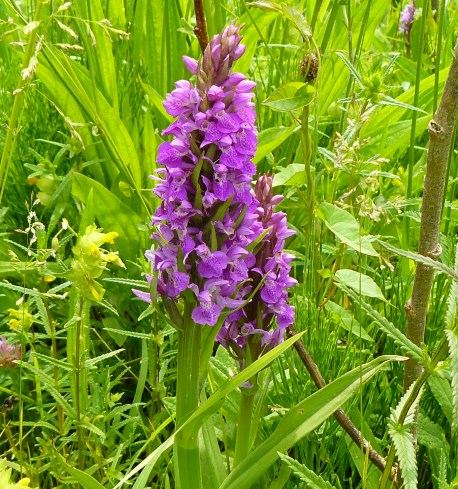
I marked most of the
flower spikes with sticks except where they clustered
together. I counted another 9 Southern Marsh Orchid
spikes on the Lumley area which gives a grand total of
36 for the meadow as a whole. I assume there are none
elsewhere! We are already exceeding counts in previous
years and there is still time for more!
I had a nice chat with
a lady named Diana from Westbourne who regularly walks
her dog on the meadow. She was not aware of the
orchids so I showed her some near the twig barrier
which she was delighted to see. I also gave her a
brief history of the conservation group and its
excellent work in looking after the meadow for the
benefit of wildlife and the enjoyment of the local
community. I gave her a Brook Meadow Conservation
Group leaflet.
Ragged
Robin count
While on the
Lumley area, I also did a count of the Ragged Robins
which were literally all over the place! They were
certainly not easy to count, as one plant usually has
several flowering branches. I tried to count just the
plants and not the flowers. In all, I counted 370
flowering plants on the Lumley area with a further 63
on the centre meadow making a grand total of 433.
A
nice little cluster of Ragged Robin
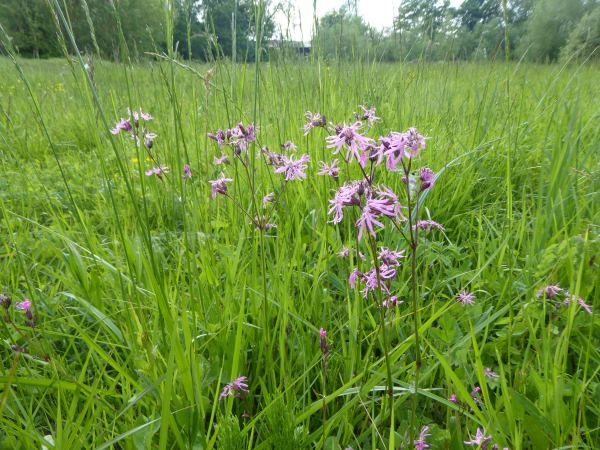
As can be seen from
the following chart this is the second largest count
since the counts started in 2002, topped only by the
whopping 625 in 2012. My guess is that this large
count is weather related as we had a particularly wet
and cold winter and spring, as I recall. We should not
overlook the excellent management of the site by the
conservation group who carefully cut and cleared the
area in the winter period.
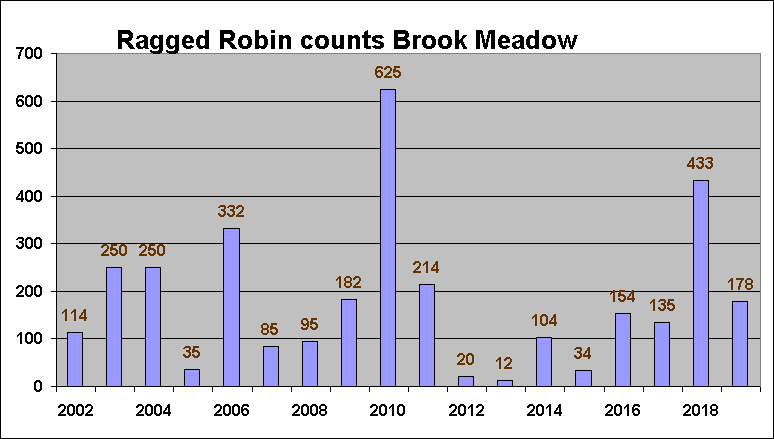
There are several
clumps of Common Comfrey on the Lumley area, both
white and purple flowered.
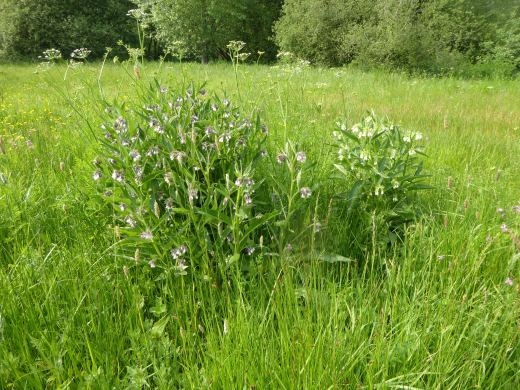
The umbellifer flowers
in the photo are Hemlock Water-dropwort. We do need to
be mindful of the increasing presence of this plant on
the Lumley area which can quickly spread and dominate
other plants. I recall the group digging out these
plants.
Swifts
Fiona Bangert
e-mailed to say there was a group of around 10 Swifts
screaming through the skies last night after 6pm over
Gordon Road, - not far away from Bridge Road where I
had just 4. That is good news for a bird that has
become seriously threatened in recent years. Any other
Swift sightings in Emsworth area would be very
welcome.
Fiona also gets bats flying around her house from
about now.
MONDAY
MAY 21 - 2018
Brook
Meadow
I counted 18
Southern Marsh Orchids open on the main orchid
area on the north meadow, plus another 4 on the Lumley
area making a grand total of 22. I have marked most of
them with sticks. The Southern Marsh Orchid count for
the past 5 years has been over 30, so I am hoping for
more in the near future to break the record. Here is a
photo I took of one today. They are looking good!

I had a close look at
the Forget-me-not that Ros Norton found on Brook
Meadow during the Saturday walk which she thought
might be Changing Forget-me-not. I am not at
all confident in identifying different species of
Forget-me-not, but this plant, as noted by Ros, has
both cream and blue flowers. This fits the
identification of Changing Forget-me-not, ie the tiny
flowers change from yellow or cream to pink or blue as
they open. If this is confirmed it would be a first
for the Brook Meadow plant list.

Swifts
We had 4
Swifts flying fairly low over our house in Bridge Road
Emsworth this evening, low enough for them to be
included on my garden list. We have been seeing Swifts
in the Bridge Road area for a couple of weeks, but
generally flying high. These are the first low fliers
in the evening, lets hope they will nest somewhere
local so we can see family parties screaming around
the rooftops. Heather Mills and others saw 4 over
Bridge Road car park on Saturday morning, so these
must be our regulars.
SATURDAY
MAY 19 - 2018
Brook
Meadow Walk
I met up with
seven members of the Friends of Wildlife (formerly
Havant Wildlife Group) in Bridge Road car park for
their annual visit to Brook Meadow. Numbers may have
been reduced by a clash with the royal wedding of
Harry and Megan!
Before I arrived the group had seen 4 Swifts
flying in the sky, which is the most we have had in
the area so far this year. Let's hope they build up,
but I am not optimistic as numbers have plummeted over
the last 10 years. Heather captured one in this photo.
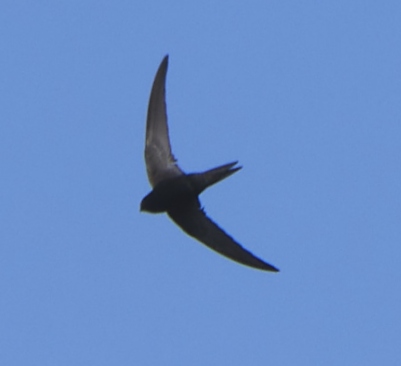
Arriving at Brook
Meadow, we entered through the Seagull Lane gate and
stopped for a moment to look along the recently
cleared path though the dense vegetation to the new
Oak trees which are all doing very well, including the
one that I planted! We stopped for the traditional
group photo before going across the north bridge onto
the main meadow.
From left to
right in the photo are Derek, Dave, Ros, Nicola,
Heather, Fay and Neil.
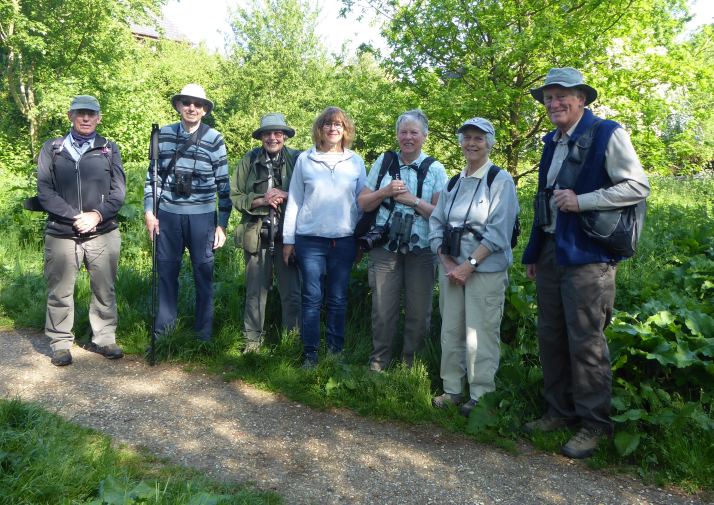
The group was
impressed with the good work done by the conservation
volunteers in clearing the river banks and admired the
avenue of Cow Parsley along the main path.
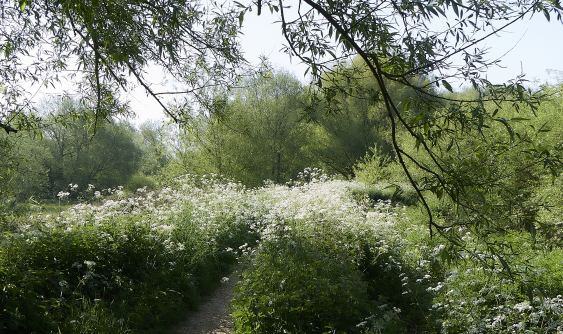
While in the north
meadow we stopped for a while to examine several
grasses, including Meadow Foxtail, Cocksfoot and Tall
Fescue. I was particularly pleased to find the first
Yorkshire Fog of the year and invited Nicola to stroke
its velvety stem.
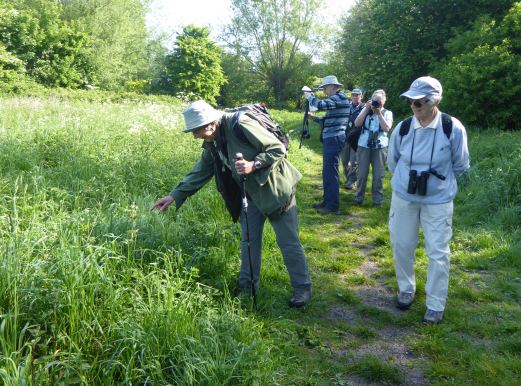
This reminded us all
of Gwynne Johnson's determined efforts get us to
understand and identify grasses. Talking of Gwynne we
stopped briefly by the group of Rowan trees which were
planted in her memory in 2004 and carefully maintained
by the conservation group.
I invited the group
onto the main orchid area which is currently
surrounded by a temporary barrier of branches to
restrict access. This was a good move as Dave
discovered the first of several Southern Marsh
Orchids, just starting to flower and very late
this year. We discovered another couple of Southern
Marsh Orchids on the Lumley area.

The first of the
Southern Marsh Orchids
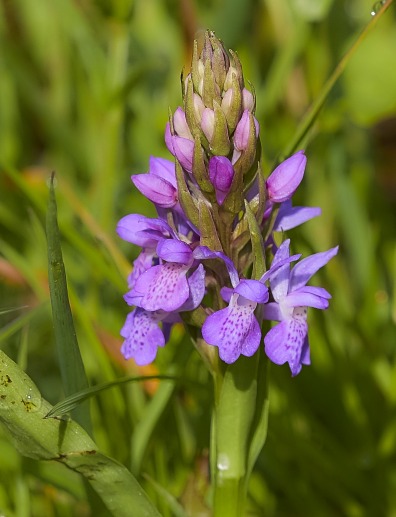

While on the Lumley
area I introduced Nicola to sedges, in particular
comparing Distant Sedge with the similar structured
Hairy Sedge.
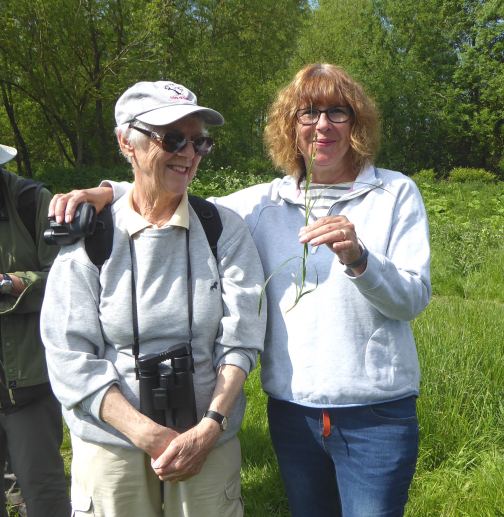
Near the Lumley Stream
we saw several damselflies, including a male Beautiful
Demoiselle an Azure and a pair of Large Reds mating.
We also came across several Froghoppers and a Red
Cardinal Beetle.
Looking for
damselflies
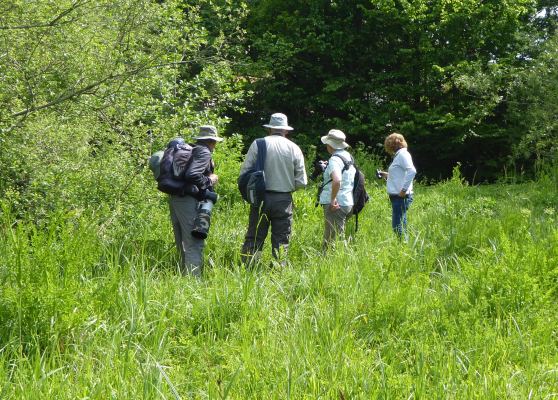
Ros had a look at the
Wintercress flowering on the centre meadow and decided
it was probably B. vulgaris in view of
its large basal leaves.
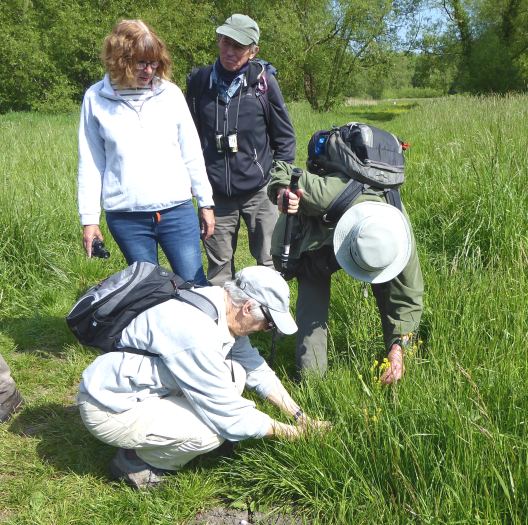
Walking along the
causeway towards the seat for our break we stopped to
admire the attractive pink and white blossom of a
Hawthorn bush.

We stopped for a
coffee break at the main seat overlooking Brook Meadow
where I asked Heather to take a photo of the group
with me in it for a change!

Ros puzzled over some
Forget-me-nots with white and blue flowers and
concluded they were probably Changing Forget-me-not,
but not with complete certainty. Here she is looking
them up in her flower guide.

Best of all for me was
to confirm the presence of at least three male
Whitethroats singing on the meadow for the
first time this year, one from the west side of the
north meadow, one from bushes around the causeway and
another from trees on the edge of the south meadow.
Clearly, they are here at least. Here is a nice shot
of one perched at the top of a tree from Derek.
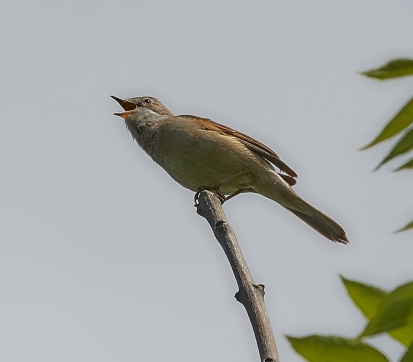
Finally, I took the
group on a trek through the jungle which is the south
meadow hoping for Celery-leaved Buttercup, but not a
sign of anything of interest. So, I bid a fond
farewell to the group at the south gate at about 11am.
In fact, the group did find Celery-leaved Buttercup on
the side of Peter Pond which I recorded on May 17th.
But none on the meadow this year.
PS Thanks to Heather
and Derek for the photos. Some were mine as well.
FRIDAY
MAY 18 - 2018
Portsdown
Hill
I had a short
walk along the lower slopes of Portsdown Hill below
Fort Widley this morning. I enjoyed great views across
Portsmouth and the harbours, but not many wild
flowers.

I found several lovely
clumps of flowering Crosswort along the path by
the road, but very little else. Certainly, no sign of
any orchids, though I did not check behind the fort
where they are usually found.
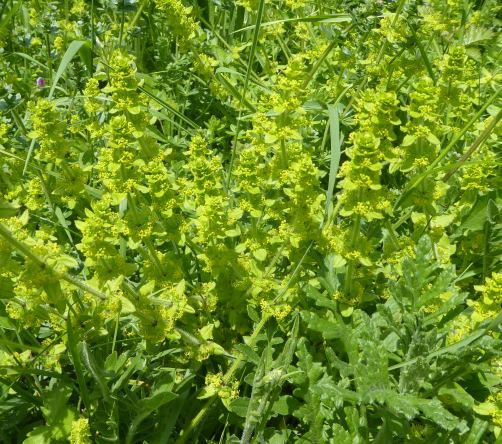
On the slope I found
Salad Burnet in flower along with some
Bird's-foot Trefoil
and Common
Gromwell.
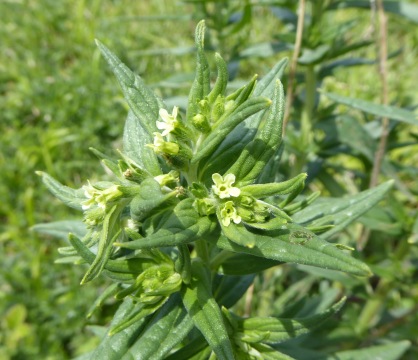
Upright Brome
which is the main Portsdown Hill grass was fairly
prominent, but not prolific. This is another sign of
how late the wild flowers are this year.
THURSDAY
MAY 17 - 2018
BROOK
MEADOW
Work session
It was a fine,
if rather chilly morning for the regular third
Thursday in the month work session. Volunteers were a
bit sparse this morning, only 6 attending. The main
tasks were grass cutting. The power scythe was used to
cut Brian's path in the Seagull Lane patch and the
path around the Lumley area. The growth around the
Rowans and Cheery trees cleared by hand.
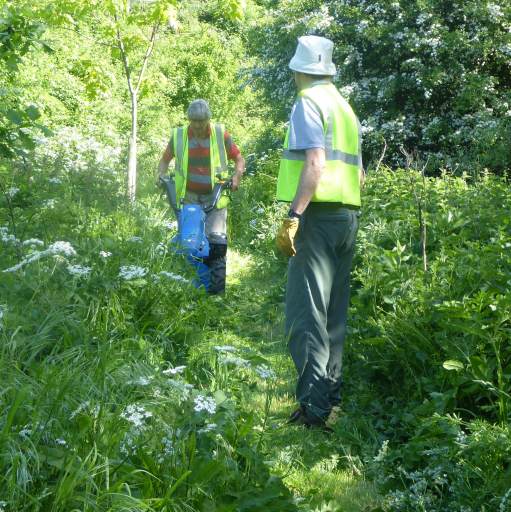
The big surprise was
to see Malcolm Phillips back on the meadow - on a
flying visit from his new home in Cuba. We do miss his
fine photos and keen eyes in spotted wildlife. Malcolm
(second from the right) stayed for a cup of coffee
with the team. He's hoping to get the internet fixed
up at his Cuban home so we shall then be able to
communicate. He says the birds and butterflies in Cuba
are wonderful!
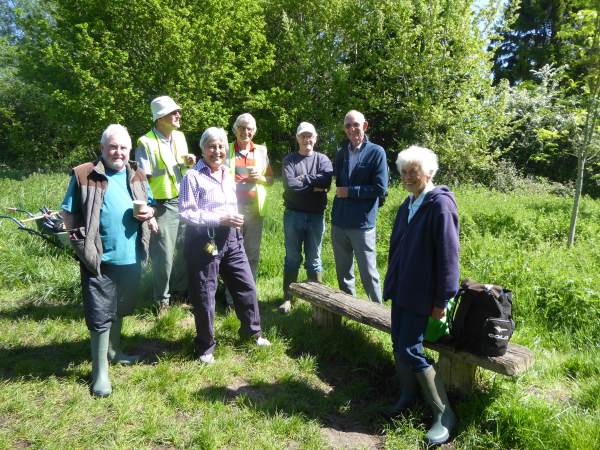
We met for coffee
break at Beryl's seat on the east side of the north
meadow and Pam filled us in with a little of its
history. Beryl Young donated the seat to Brook Meadow
in memory of her husband about 10 years ago. They used
to come and sit on the meadow and Beryl helped on
conservation work on the meadow for a while.
For the full workday
report with more photos please go to . . .
https://www.brookmeadow.org.uk/conservation-news/
Wildlife
Pam Phillips
alerted me to the emergence of Ragged Robin
flowers on the Lumley area - a good 2 weeks later than
usual and, actually, the latest date ever. Just shows
how natural growth was delayed by the cold spring. I
went over later in the afternoon and counted a total
of 111 flowering plants, 78 on the Lumley area and
another 33 on the centre meadow, with more to come
hopefully. Last year we had a peak of 135 flowering
Ragged Robin by 20 May but they were much earlier that
year.
Here is one
typically ragged flower I took today

Silverweed is
in flower on the Lumley area for the first time. I
confirmed the presence of a Whitethroat singing
near the causeway, but only one so far. We regularly
get 4 or 5.
Following my discussion of Froghoppers producing
cuckoo spit in yesterday's blog, here is some I found
on a Cleavers plant.
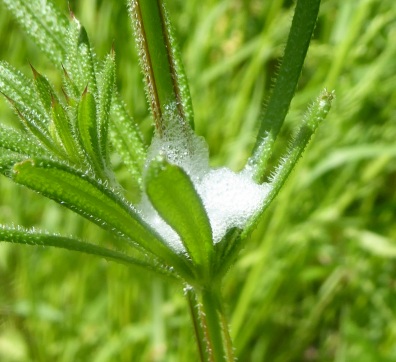
Slipper
Millpond
I was alerted
by Mark Ringwood that the Great Black-backed Gulls
chicks had hatched on the south raft of Slipper
Millpond today. I went down this afternoon and
discovered three chicks, as in previous
years.
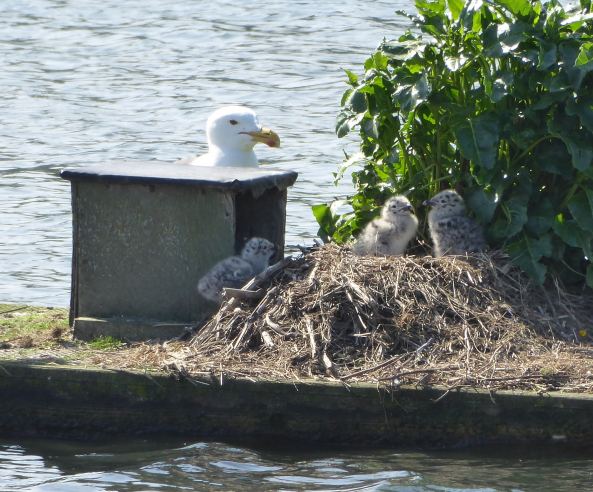
Here
is a YouTube link video of them being
fed . . .
https://youtu.be/dCZmAbgXJgE
There was no sign of
the Canada Goose family with 4 remaining goslings. It
looks as if they made a quick getaway, probably not to
be seen again, as they did last year. A Reed Warbler
was singing from the reedbeds on the east side of the
pond.
Peter
Pond
The Mute Swan
continues to incubate her eggs on the nest in the
reeds. I think hatching should be due in a week or so,
though I could not record the laying.
At least two Reed Warblers are singing from the reeds
on Peter Pond.
There is a nest of what looks like Brown-tail Moth
caterpillars on a Hawthorn bush on the south side of
Peter Pond near the footpath. The hairs and nests of
these creatures can be a skin irritant and are best
avoided.
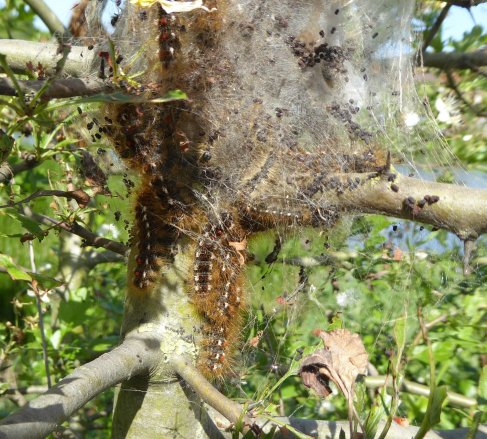
Nearby was another
caterpillar on a Red Clover plant which I think was
5-spot Burnet Moth caterpillar. These
attractive moths are usually common on the patch of
land to the south of Gooseberry Cottage which is
actually owned by Lillywhite's Garage - cut off from
the garage by the building of the 'inner-by-pass'.
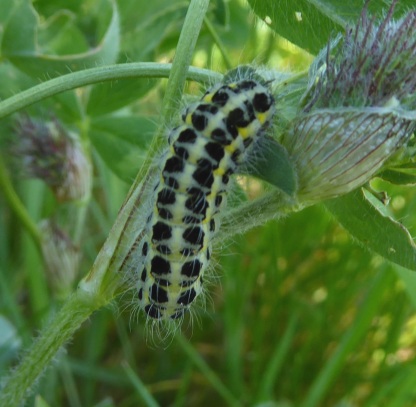
There was a Mallard
family with 7 ducklings on the pond.
I was surprised to
find a fine plant of Celery-leaved Buttercup in
full flower on the west side of Peter Pond - the first
I have ever seen in this location. These tend to be
brought in with new soil. We had an abundance of them
on the east side of the south meadow on Brook Meadow
in 2016, presumably brought in with the Environment
Agency work on flood protection. They have not been
seen since!
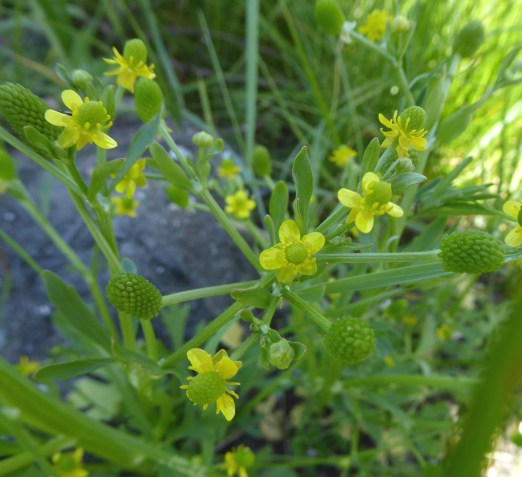
Gulls
nesting on Colt factory
Peter
Milinets-Raby had a look at the Colt Factory site
today at 12:30pm. There were 3 pairs of Herring Gulls
that had amazingly returned to nests left on suspended
apex beams (very precarious - no roof - see photo) and
there were another three confirmed nests on the
untouched westernmost building (with a possible 3 more
pairs out of direct sight from the road), so I
estimate 6 to 9 pairs have survived out of a possible
22 pairs. Alas, none of the Lesser Black-backed Gulls
survived. I will check now and then to see how the
chicks cope, especially those on the
beams!!
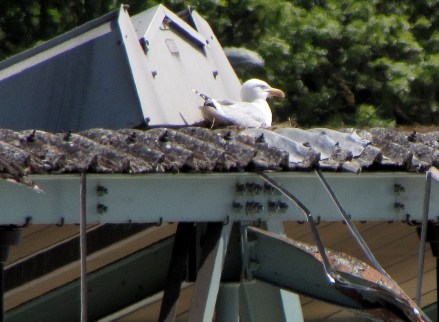
Tristan Norton (HBC
Ecologist) confirms that all demolition works on the
Colt site have ceased and will not resume until
nesting activity has finished of its own accord - this
should be mid-July if nests are successfully fledged.
WEDNESDAY
MAY 16 - 2018
Brook
Meadow
I spent about
an hour wandering around the meadow with my point and
shoot camera at the ready this morning. It was lovely
to see fresh green leaves and white blossom adorning
trees and bushes plus wild flowers and grasses waving
gracefully in the light wind. What a beautiful
place!
The entrance gate at the end of Seagull Lane has an
interesting selection of plants, mostly in flower,
including Garlic Mustard, White Dead-nettle,
Shepherd's Purse, Broad-leaved Dock, Barren Brome,
Annual Meadow-grass and also Hedge Mustard
(first of the year).
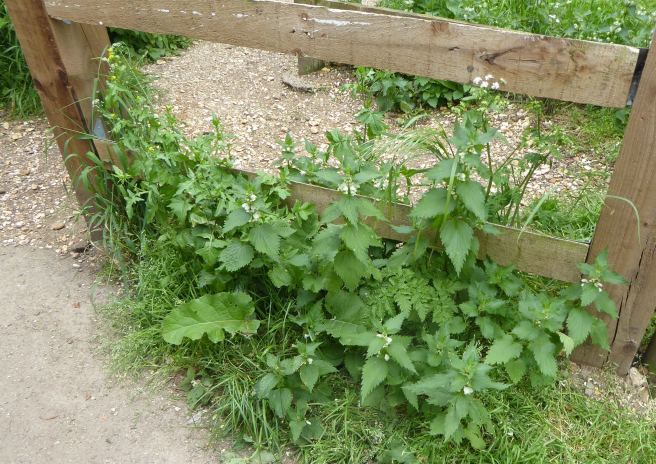
Hedge Mustard
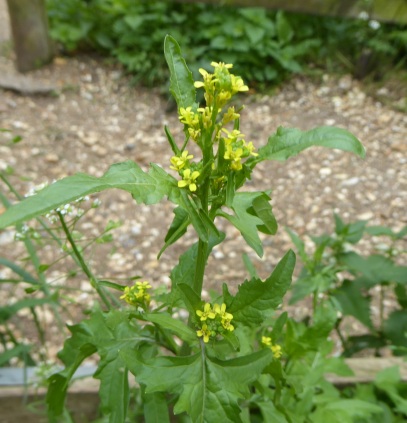
Walking along the path
to the north bridge I noted the burgeoning leaves of
Lesser Burdock not to be confused with the
similar but smaller leaves of Broad-leaved Dock and
Greater Plantain.
The tiny, barely
visible white flowers of Cleavers are now
peeping out.
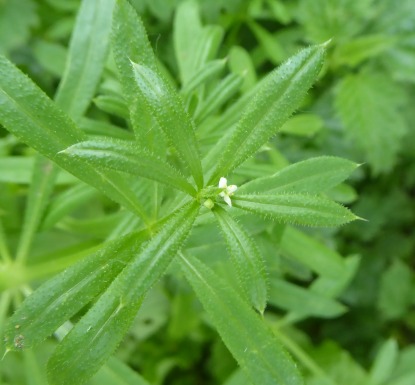
Onto the north meadow
I stopped to admire the tall plants of Broad-leaved
Dock showing the reddish flower buds not fully
open.

Some of the grasses
also have a reddish tinge to them, e.g., Meadow
Foxtail, Tall Fescue and Cocksfoot.
I had a look around
the areas of grassland that the volunteers have mown
several times over the winter period. This seems to
have paid off as I found the northern of these areas
had a good crop of Hairy Sedge. It may well
have been there before the clearance, but no one would
have known. This photo just shows the distinctive
hairy leaves.
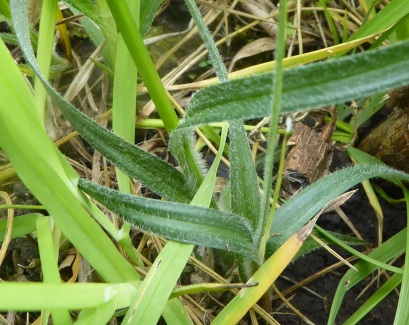
I also had a look
around the main wild flower area on the north meadow
which is now ringed with a temporary twig barrier to
prevent walker encroachment. No sign of orchids as
yet, but I am expecting the first Southern Marsh
Orchids in the next week or so. However, the
attractive yellow flowers of Yellow Rattle are
now out and should multiply fast.

The only insect I
noted was a vividly coloured Red-and-Black
Froghopper (Cercopis vulnerata).
There are many different species of Froghopper, but
this is the one we usually see on Brook Meadow,
probably because it is so colourful.
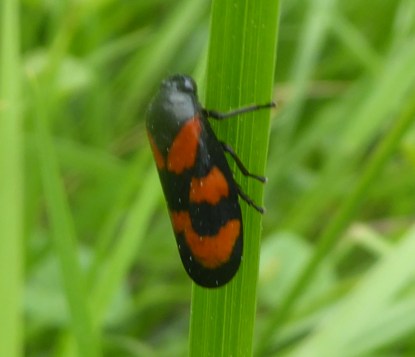
They get their name
from their ability to jump many times their height and
length, but are best known for their plant-sucking
nymphs (beloved by gardeners!) which encase themselves
in foam in springtime. These nymphs are usually called
Spittlebugs. The foam is well-known as 'cuckoo spit',
named presumably because its appearance coincides with
the arrival of the Cuckoo. Cuckooflowers are similarly
named.
I am increasingly
concerned about the Whitethroat which I have
not heard for a couple of weeks. All is quiet.
MONDAY
MAY 14 - 2018
Wayside
flowers
I had a walk
around some of the local waysides this morning. The
most interesting one by far was the grass verge at the
junction of New Brighton Road and Horndean Road which
had been mown only at the edges, leaving a good area
of wild flowers and grasses in the centre. Something I
have noticed generally about local waysides is that
most of the grass verges had only been partially cut,
leaving a nice area, usually in the centre of
flowering plants. The waysides message has taken root!
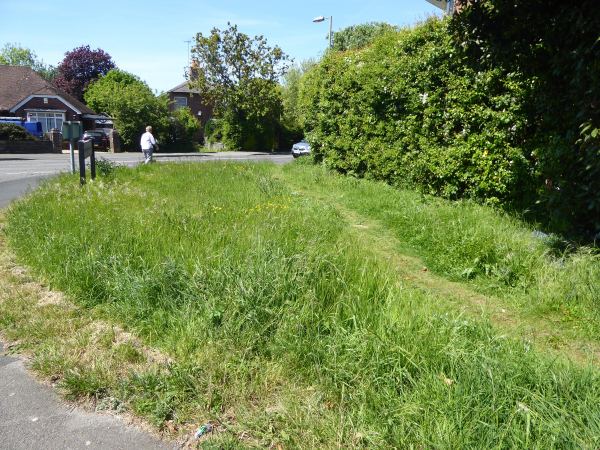
In this small area I
noted the following wild flowers Common Mouse-ear, Red
Clover, Ribwort Plantain, Meadow Buttercup, lots of
Bulbous Buttercup, Common Comfrey, Cleavers, a good
patch of Germander Speedwell, Cut-leaved Crane's-bill,
Spotted Medick, Daisy, Common Field Speedwell,
Dandelion, Common Vetch, Garlic Mustard and Hawthorn.
Grasses in flower included Soft Brome, Barren Brome,
Cocksfoot, Smooth Meadow-grass, Tall Fescue and False
Oat-grass - my first of the year.
Cut-leaved
Crane's-bill . . . . Germander Speedwell
Beaked
Hawk's-beard
On the way to
the junction wayside, I noted two excellent plants of
Beaked Hawk's-beard (Crespis visicaria)
in full flower growing partly on the concrete base
under the A27 bridge on the west side of Horndean
Road. Beaked Hawk's-beard is always the earliest of
the multi-flowered 'Dandelion-like flowers' to emerge
in spring and so is relatively easy to identify.
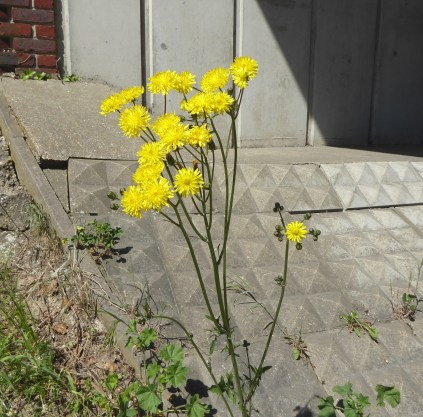
Smooth Hawk's-beard is
similar, but it flowers later than Beaked Hawk's-beard
and its flowers are smaller. The outer florets of both
are often tinged orange beneath. Beaked Hawk's-beard
was introduced into this country probably as a
grass-seed alien in 1713 and is still spreading
northwards in waste places, waysides and on walls. It
is still rare in northern Britain where it is probably
reaching its climatic limits. Its present distribution
is mainly southern and eastern England.
Cardinal
beetle?
The only insect I noted was an all red beetle which I
think is one of the Cardinal Beetles( Pyrochroa
serraticornis).
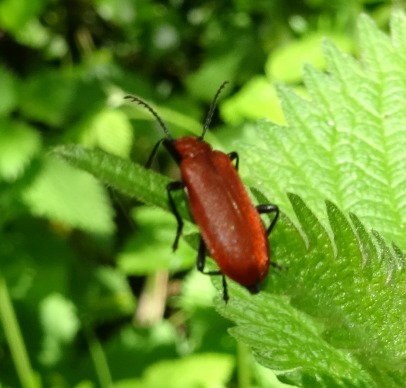
Conigar
Point
Peter
Milinets-Raby had a brief outing to Conigar Point this
morning (9:06am for an hour).
Tide just pushing in - no waders like last time except
for 1 Whimbrel.
Other birds of note included: 2 Swallow, 1 Little
Tern, 2 Common Tern, 1 Sandwich Tern, 1 Great Crested
Grebe, 1 Shelduck, a male Linnet on the seaweed (see
photo).
2 Reed Warbler singing
in the mini reed bed behind the point
Ibis field: 1 Whitethroat, 1 Chiffchaff, 1 Blackcap
and a female Pheasant.
By the farm: A Grey Wagtail singing and a Buzzard
soaring over.
SUNDAY
MAY 13 - 2018
Brook
Meadow
Jean and I
took a stroll through Brook Meadow on this fine and
sunny morning. We enjoyed walking down the aisle of
Cow Parsley and admired the river flowing beneath us.
Gosh, it is so good to see the river flowing so well
now the banks have been cut back. It is an experience
not to be missed!
Jean's keen eyes
spotted a single flower of Yellow Flag out on
the west bank of the river south of the S-bend. This
is the first of the year and about a week later than
usual. She also noted the first pink flower of
Common Vetch on the causeway. I would probably
have missed both these flowers if I had been on my
own!
We walked down to
Peter Pond to check the swan's nest. The pen was snug
on her nest and incubating her second batch of eggs.
These will not be hatching until next month.
On our way back
through the meadow I was over the moon to discover a
small patch of Hairy Sedge (Carex
hirta) growing beside the eastern path through
the north meadow, close to the Rowan plantation. Grid
Ref: SU 75074 06119. Hairy Sedge is notoriously
difficult to find as it is so similar to Distant Sedge
in general appearance except for the hairs on the
sheaths and leaves. This was my first record of Hairy
Sedge on Brook Meadow since 2015.
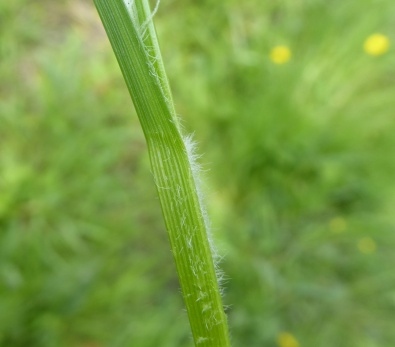
Just after the Hairy
Sedge, we stopped to admire the wonderful blossom on
the Rowan plantation which was planted in
memory of Gwynne Johnson. It was Gwynne more than
anyone who inspired my interest in grasses and sedges
This photo does
not do it justice.
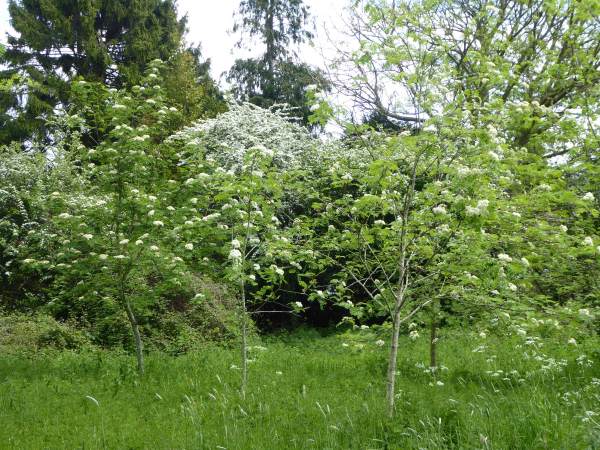
Finally I discovered
what I think is another example of the fungus
Dryad's Saddle on a Willow log near the north
bridge.
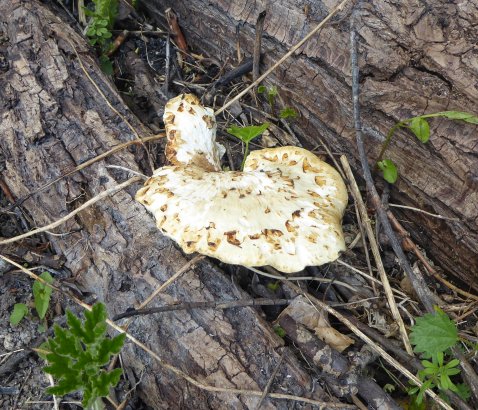
During the walk we
stopped to chat to a couple from Southsea making their
first ever visit to Brook Meadow and they loved it!
Paul explained that he was a biology teacher near
retirement with a special interest in reptiles. He
said he would like to get involved in the conservation
effort, so I gave him my card with contact details and
hoped to see him again.
SATURDAY
MAY 12 - 2018
Warblington
shore
Peter
Milinets-Raby was up early and had a walk along the
Warblington shore - from 6:06am to 8:30am - tide
slowly pushing in. The highlights were as follows:
Cemetery - 1 singing Whitethroat.
Ibis Field: 1 singing Whitethroat, Pheasant heard and
3 Med Gulls over. 1 singing Skylark
Mini reed bed behind Conigar Point: 2 singing Reed
Warblers heard
Conigar Point: 4 Shelduck, 4 Great Black-backed Gull,
3 Lesser Black-backed Gulls, 4 feeding Little Terns
along with 7 Common terns and 3 sandwich Terns. 7 Med
Gulls over.
As the tide pushed in the waders started to feed on
the mud by the point and consisted of 1 bar-tailed
Godwit, 3 Whimbrel, 1 Grey Plover, 14 Ringed Plover
and 21 Dunlin (these in summer plumage)
Off Pook Lane: 3 Great Crested Grebes, 1 Whimbrel, 1
Shelduck, 3 Lesser Black-backed Gull.
And the bird of the morning was a Hobby that flew
south over the SSSI field, then headed further south
across the Sweare Deep to Hayling Island.
Baffins
Swan family
Eric Eddles
reports from Baffins Pond that the Mute Swan family
with their 6 cygnets are doing very well.
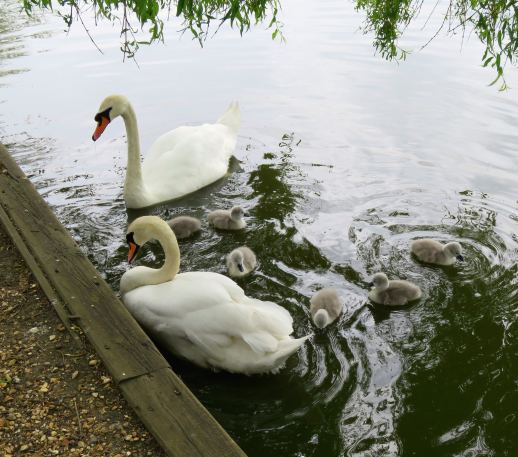
THURSDAY
MAY 10 - 2018
Brook
Meadow sedges
The Lumley
area now has its full compliment of sedges, all of
them in flower. Divided Sedge is widespread and
is as good as I have ever seen it.

Others include Greater
Pond Sedge, Distant Sedge, Slender Spike-rush,
False Fox Sedge, Common Spike-rush - the
latter two pictured below.
Of the 15 sedges on
the Brook Meadow list I have recorded 9 so far this
year. The other 6 are still to be found in other areas
of the meadow.
I spotted this splendid Nursery-web spider
sunning itself with its front legs stretched out in
typical fashion.
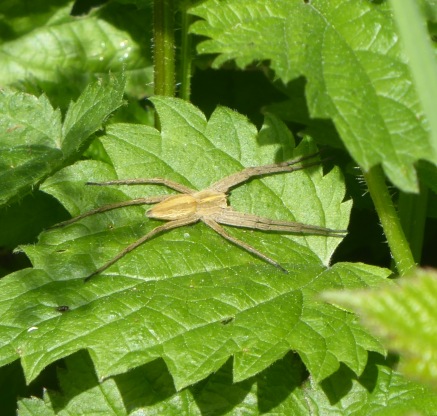
Hermitage
Millponds
Mute Swan was
on its nest in the reeds on the south west corner of
Peter Pond. A few days ago, Maurice Lillie spotted 4
eggs, so she could well have a few more by now. I
hoped she starts incubating soon.
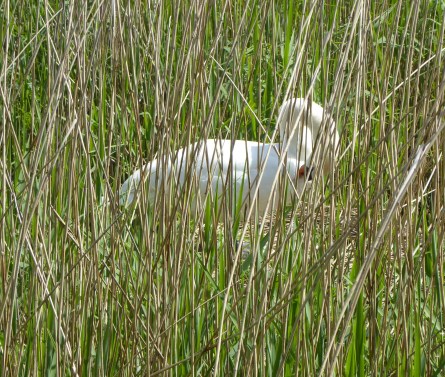
At least two and
possibly three Reed Warblers were singing from the
reeds on the west side of Peter Pond, but none were
visible.
Walking across the
main road towards Slipper Millpond I noted a good
flowering of Beaked Hawk's-beard under the
large Hampshire sign on the grass verge.
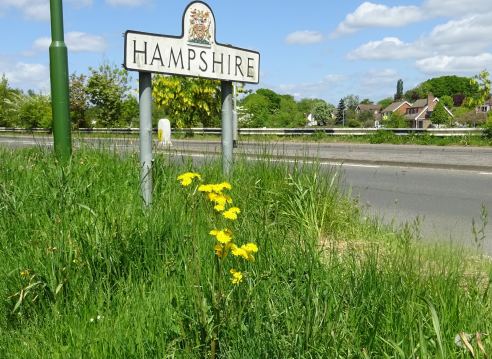
Hedge Mustard and Red
Clover were also in flower along with a variety of
grasses, including Barren Brome, Soft Brome,
Cocksfoot. I also noticed Musk Storksbill in flower on
the boat island at the bottom of Queen Street.
The Canada Goose
family was on Slipper Millpond with 4 goslings,
down one since I last saw them.
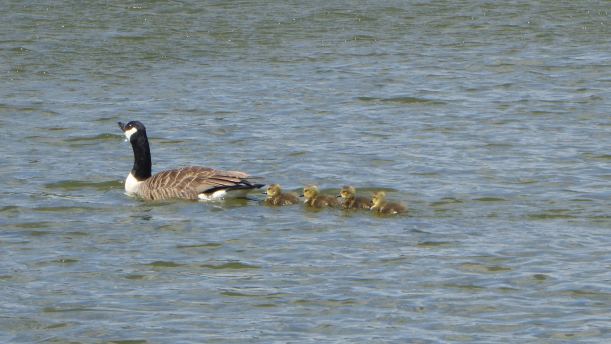
While I was there the
cob swan from the Peter Pond pair was aggressively
chasing one of the Canada Geese. The other goose
sensibly took her brood to the safety of the island.
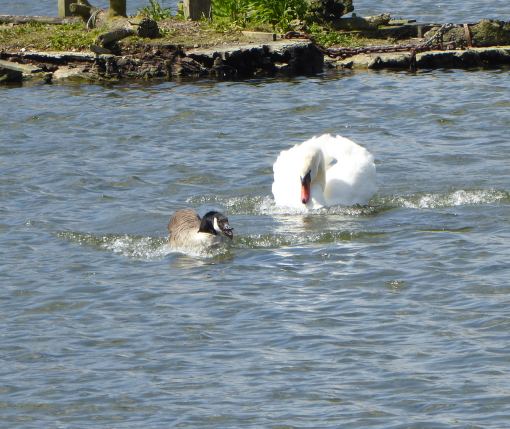
The Great Black-backed
Gull was snug on its nest on the south raft.

While standing on the
Hermitage Bridge I watched a fine (though not all that
unusual) spectacle of over 100 Grey Mullet swimming in
the shallow water below me. What graceful creatures.
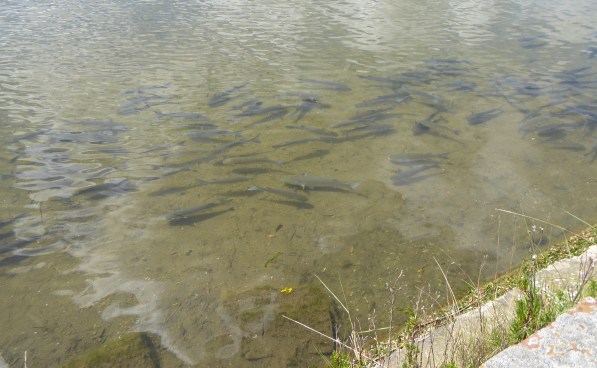
Here is a short video
clip I made at the time . . . https://youtu.be/nBl_bRuUBe4
Langstone
Mill Pond
Peter
Milinets-Raby briefly visited Langstone Mill Pond this
lunchtime 12:48pm for an hour - low tide. He had 4
Common Tern, a single Sandwich Tern and 2 Little
Terns, plus 2 Great Crested Grebes.
On the pond were 2 pairs of Tufted Duck, the Mute Swan
was still on the nest, 3 Reed Warblers were singing
along with singing Cetti's Warbler.
Little Egrets were very quiet with birds sat on nests.
No new building of nests, but the nest on the island
has been abandoned - shame. So probably only 21 pairs
this summer (50% down on last year).
Grey Herons: Nest 10: Has one juvenile. Nest 7: Has
two young. Nest 4: has two tiny young.
Baffins
Pond cygnets
Eric Eddles
reports that six cygnets were out to-day for the first
time on Baffins Pond. Are they the first?
WEDNESDAY
MAY 9 - 2018
Nests
on Colt factory
Peter
Milinets-Raby has been closely monitoring the
demolition of the old Colt factory in New Lane Havant
on the roof of which Herring Gulls and Lesser
Black-backed Gulls have been nesting. Yesterday, Peter
was shocked to see that over 3/4 of the outbuilding
had been demolished leaving just three Herring Gulls
nests. So, in the space of a morning 19 Herring Gulls
nests and 2 Lesser Black-backed Gulls nests had been
destroyed! Here is one determined gull sitting it out
in the face of an approaching demolition machine.
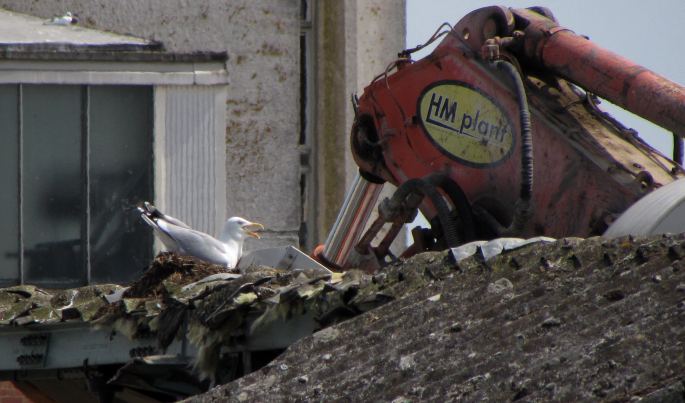
Since then, Tristan
Norton the ecological advisor for Havant Borough was
alerted to the problem. He got the site contractor to
cease work until their own ecologist could visit to
assess the situation. It is unlawful to disturb Lesser
Black-backed Gulls, but apparently not Herring Gulls.
So watch this space!
Peter drove by this evening and noted that the
furthest outbuilding (west end) was still intact. This
building held at least three nests of Herring Gulls
that he could see - there maybe more tucked in the
groves of the roof. This was the roof that the Lesser
Black-backed Gulls nested on, but the disturbance has
pushed them off!
TUESDAY
MAY 8 - 2018
Brook
Meadow
It was a
lovely warm morning, windless and not too hot, for a
mooch around the meadow. It was good to find nature
stirring at last after this uncommonly cold and wet
spring.
Pride of place must go to the glorious avenue of the
aromatic white lace-like flowers of Cow Parsley
that forms at this time of the year along the main
river path south of the north bridge. This is one of
Brook Meadow's finest spectacles and must be
experienced. They will be here for another few weeks.
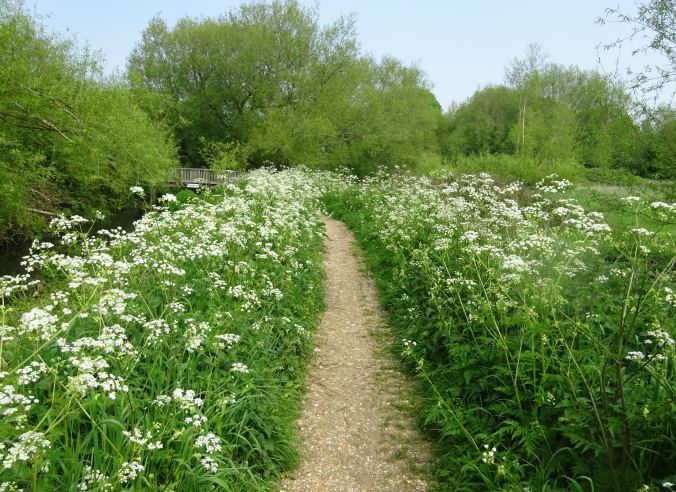
Somewhat less
striking, but equally fine, are the Common Comfreys
on the Lumley area, some flowered white, others
purple.
Even less striking are
the flowers of Ribwort Plantain and Common
Mouse-ear which are now out on the main orchid
area.
Grasses
have been particularly slow this
spring, apart from Meadow Foxtail
which has been out for several
weeks and is now flowering well and
covered in anthers.
|
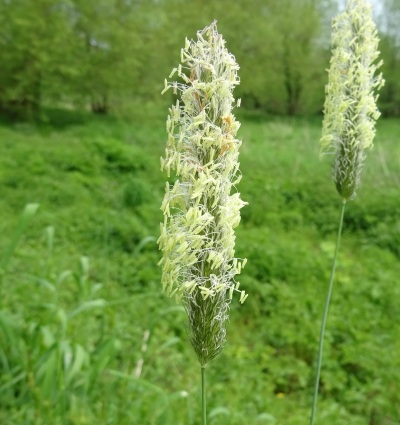
|
New grasses for this
year included Cocksfoot and Rough
Meadow-grass - the latter lining the main river
path. Both are a good two weeks later than usual.
I was particularly
pleased to locate a good patch of Smooth
Meadow-grass on the centre meadow (west) at as
this is a scarce grass on the meadow and difficult to
find among all the others. The easiest way to
distinguish the these two meadow grasses, apart from
the roughness of the stems, is to examine the ligules
where the leaves meet the stem; in Rough Meadow-grass
these are long and ragged, in Smooth Meadow-grass the
ligules are short and blunt (on the right in the
photo).
|
Suprisingly
few butterflies were on the wing this
morning. I only saw a few Whites and Orange
Tips and a single Peacock which
settled on the river bank for a photo.
|
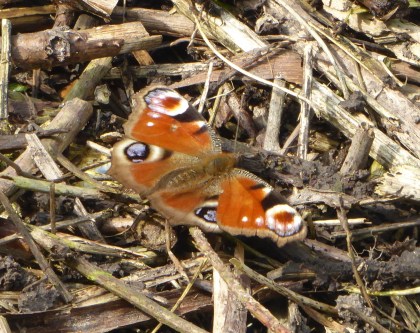
|
|
I found a
very tiny Ladybird resting on a grass leaf
which may be a 24-spot. 24-spot
Ladybirds usually have 24 spots, if you
can count them that is, but are variable!
Their habitat is grasslands and they feed on
False Oat-grass which is abundant for Brook
Meadow, though not yet out.
|
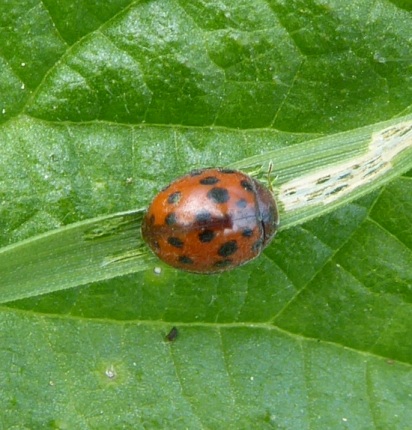
|
|
My most
unexpected sighting of the morning was a
magnificent cluster of Dryad's Saddle
fungi on the trunks of an old Crack
Willow tree on the west bank of the river
between the sluice and the S-bend. They are
easily seen from the main river path. The
large caps are flat-topped and saddle-shaped.
The fungus is named after dryads or wood
nymphs in Greek mythology. The upper side of
the caps is tan-yellow with concentric bands
of dark brown flat scales which look like
spots. Its season is spring to summer, but
unlike many other bracket fungi it does not
persist.
|

|
MONDAY
MAY 7 - 2018
Old
Colt factory
Peter
Milinets-Raby drove passed the Colt factory in New
Road, Havant this afternoon and noticed that half of
the outbuildings had been taken down leaving a
skeleton shell which as can be seen in the photos is
still harbouring nesting Herring Gulls sitting out to
the last. A very sorry state of affairs.
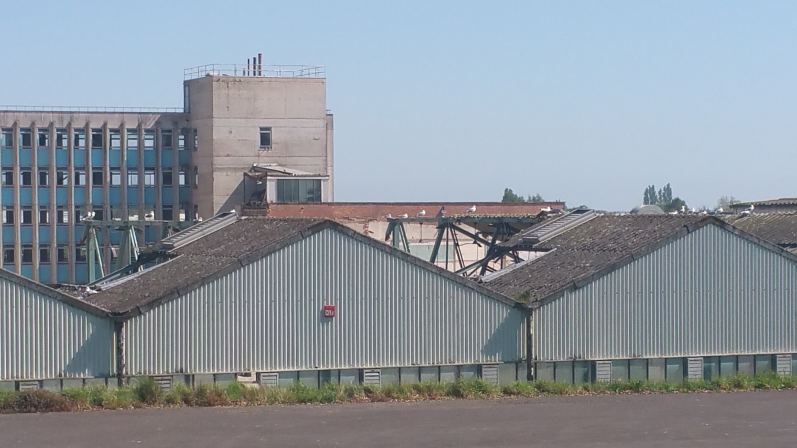
Peter thought the
demolition guys would wait until these birds had
finished breeding, but NO!!! And to think there were
22+ pairs of Herring Gulls on these roofs along with
two pairs of Lesser Black-backed Gulls (probably more
as last year I counted SIX pairs). In Peter's words,
"A shocking waste of life!"
Holly
Blues
Ralph Hollins
information about the behaviour of Holly Blue
butterflies in response to my blog yesterday.
"What you say about Holly Blue caterpillars feeding on
Ivy is true but you are unlikely to find the
caterpillars on Ivy until August. The spring
generation which feeds in May normally feed on Holly
and the adults which lay eggs around now do so on
Holly when that is flowering. In August the Holly has
ceased to flower but Ivy is in flower. "
See . . https://butterfly-conservation.org/50-923/holly-blue.html
SUNDAY
MAY 6 - 2018
Brook
Meadow workday
I went over to
the meadow this morning for the regular 1st Sunday in
the month work session. The weather was warm, hot even
for May. 11 volunteers attended plus two of Jennifer's
grandchildren. Clare Colette from the Trust for
Conservation Volunteers was also present to check on
our procedures for group insurance purposes. Clare has
taken over as the TCV representative for this area.
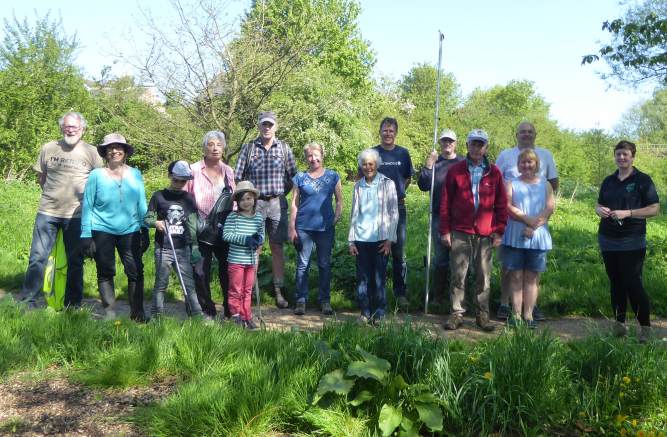
The main tasks were
clearing nettles from the river banks and paths and
erecting a twiggy barrier around the wild flower area
on the north meadow.
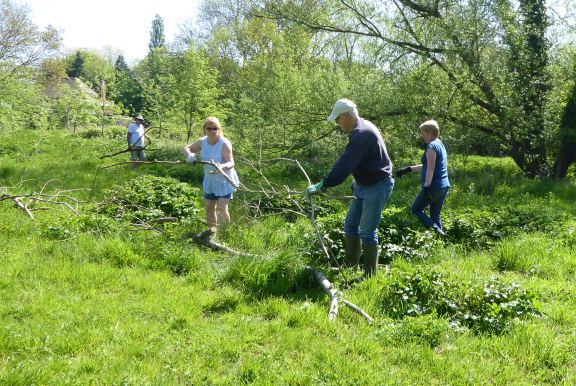
For the full report of
the work session plus more photos go to . . .
https://www.brookmeadow.org.uk/conservation-news/
Wildlife
observations
I was pleased
to hear the first Whitethroat of the year
singing from the brambles on the west side of the
north meadow. This is about 2 weeks later than usual
for this regular summer visitor to Brook Meadow.
Listen out for their short scratchy song, usually when
perched on a bush or tree, with white throat
prominent. Photo taken a couple of years ago on Brook
Meadow.
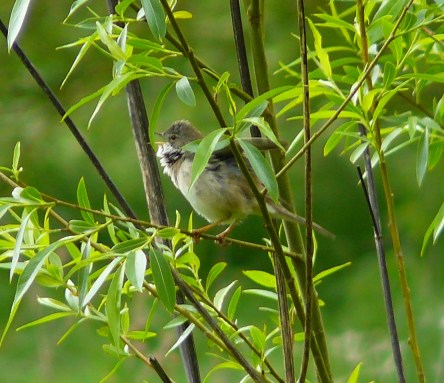
There was a good
number of butterflies on the wing, mostly whites, plus
several Orange Tips and a Holly Blue, for the
first time this year. You are very likely to see Holly
Blue in your garden fluttering high around the Ivy
which they lay eggs on. The very similar Common Blue
always flies low and frequents grassland areas. Holly
Blue has black spots on its underwings which the
Common Blue does not have.
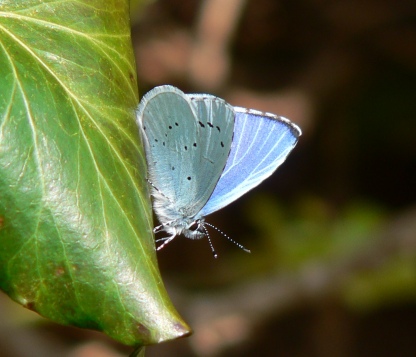
We are doing quite
well for Cuckooflowers on Brook Meadow this
year. I counted a total of 24 in total with 2 on the
orchid area, 3 on the Lumley area, 15 on centre meadow
and 4 on south meadow. This is a fairly modest number
compared with the 157 I counted on the Bridge Road
Wayside.
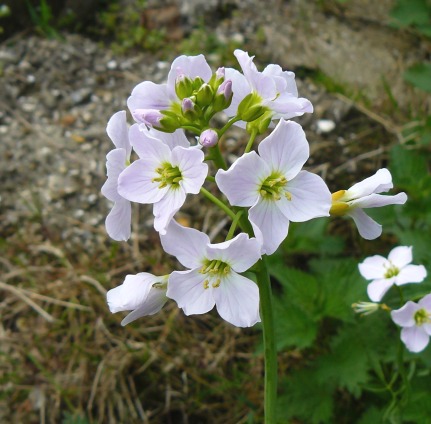
I found a good growth of what I think is Slender
Spike-rush (Eleocharis uniglumis) in
the usual spot in the centre of the Lumley area. This
plant is botanically a sedge despite its common name.
It differs from Common Spike-rush in having very thin
(slender) stems, only about 1mm thick. Slender
Spike-rush also only has the lowest glume of the
spikelet without a floret; in Common Spike-rush both
the two lowest glumes are empty. This uncommon
Spike-rush was first discovered on Brook Meadow by
ecologist John Norton during a botanical survey on
June 4 2012.
FRIDAY
MAY 4 - 2018
Canada
goslings
I went down to Slipper Millpond this afternoon to
check on the nesting birds. The Canada Goose family
were on the water and so I was able to confirm the
presence of 5 goslings.
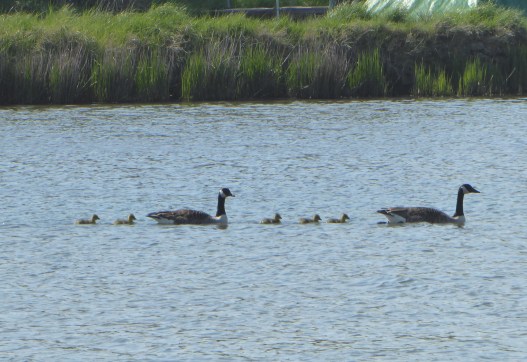
Patrick Atkin also
visited the pond and got this delightful photo of mum
with the youngsters in tow.
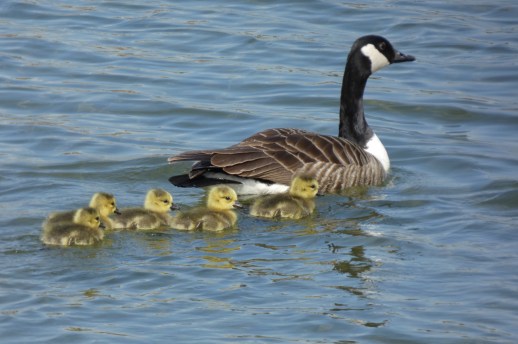
Spring
flowers
I had my first
Hawthorn (May) blossom of the year on bushes to the
south of Peter Pond. This is late as I usually see May
blossom before the start of May. I also found my first
Common Vetch near the pond.
Crow
steals fish
Jennifer Rye
had an interesting observation of clever Carrion Crow
behaviour while at Nore Barn today. Here is her
report:
"I was
walking westward along the shore path at Nore Barn
wood, and saw a crow busily pecking at something on
the grass. It flew off as I neared, I was amazed to
see the object of it's attentions was a sea bass!
Further along the path I saw two fisherman on the
beach, the tide was well in, casting their lines into
the sea. I asked, "have you just lost a catch?" when
one replied in the affirmative, I advised them to go
and get it back, as the crow had only just got into
the gills, the rest was fine. Apparently it had come
off the hook, and was scooped up from the water by the
crow! They did not take my advice though. Lucky
crow!"
Langstone
Mill Pond
Peter
Milinets-Raby briefly visited Langstone Mill Pond this
afternoon from 1:45pm to 2:45pm. Peter's report
follows . . .
Tide nearly in. On the last piece of salt marsh were
an amazing 4 Greenshank (the most I've ever seen in
May) and a Whimbrel. Also seen were 2 Sandwich Terns,
a Common Tern, 2 Shelduck, 1 Great Crested Grebe and 2
Med Gull.
On the pond were singing Cetti's Warbler, 2 Reed
Warblers, a Blackcap and a Chiffchaff.
No new news with the Little Egrets, very quiet today
with 19 nests noted (though at least 2/3 are now
hidden by foliage ).
Pulborough
Brooks
Christopher
Evans visited the Pulborough Brooks reserve with the
Havant U3A group and got some excellent sightings,
including Adders, Tawny Owls and Nightingale.
Pulborough Brooks is the only local site where
Nightingale can usually be seen as well as heard. Here
is Christopher's report:
"On a
lovely sunny day we had a most enjoyable walk at RSPB
Pulborough Brooks. Early sightings included
Chiffchaff, Song Thrush, Whitethroat and Willow
Warbler. However, the undoubted highlight of the day,
was a Tawny Owl and two owlets. They were difficult to
spot and we walked past them initially but with
slightly better directions, we found them second time
around.
Other
sightings included Lapwing, Canada Geese, a pair of
Egyptian Geese with goslings, Greylag Geese, Shoveler,
Shelduck, Wigeon, a lone Hobby and Jays. We expected
to see, or at least hear, Nightingales but as the walk
neared the end, we despaired of doing so. However, we
were finally rewarded by a clear view of one, singing
in competition with a Blackbird.
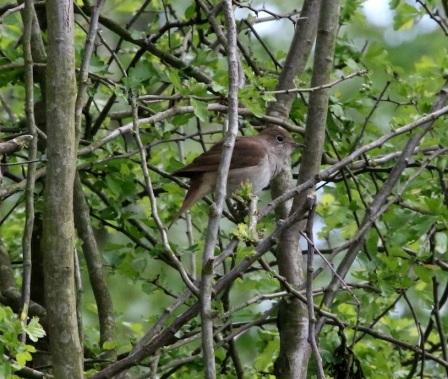
We
also heard but didn't see a Cuckoo and a Green
Woodpecker. A final non avian bonus was watching a
pair of mating Adders.
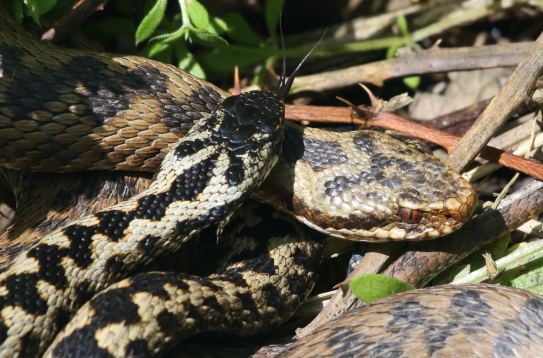
We
also thought we saw a Great Crested Newt in the pond
near the Visitor Centre but weren't 100% certain -
confirmed by nearby RSPB staff."
THURSDAY
MAY 3 - 2018
Millpond
nesting news
Yesterday, I
had an e-mail from Sharon Corbett who lives on Slipper
Road overlooking Slipper Millpond that 5 Canada Goose
goslings had hatched on the centre raft on the pond. I
went down this morning and could see 3 goslings on the
raft with the parents in close attendance; maybe
others were hidden. I met Rob, one of the Slipper
Millpond conservation group who also lives on Slipper
Road and he thought there were 4 or 5. What I assume
was the same pair of Canada Geese produced five
goslings last year.
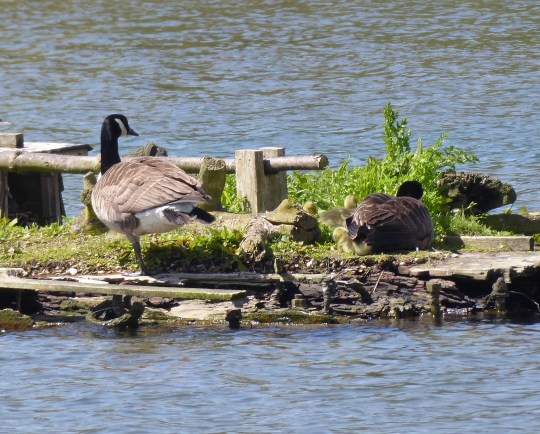
The young goslings
show up better in this short video clip . . .
https://youtu.be/jmKY26qOKXc
The Great
Black-backed Gull was sitting firmly on her
towering nest of twigs on the south raft. Their
hatching should not be too long coming.
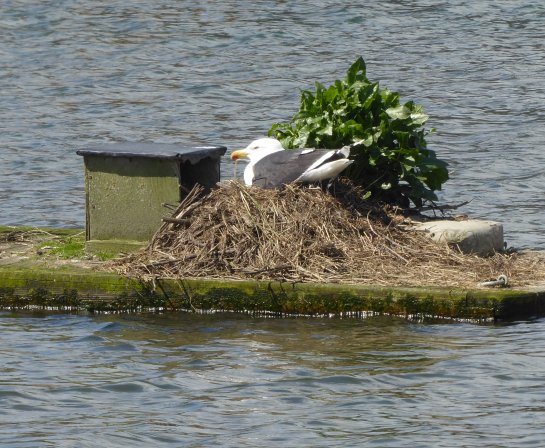
Coots were nesting on
the north raft, but no sign of any chicks. Over on
Peter Pond, the Mute Swan was sitting on her nest in
the reeds with her mate on the water.
Song
Thrush
I was pleased
to get a few nice shots of a Song Thrush feeding on
the wet path through Palmer's Road Copse. This is not
in any sense a rare bird, but is often heard far more
than it is seen.
TUESDAY
MAY 1 - 2018
Brook
Meadow
The weather
was fine, though still a bit chilly for the time of
year, for my morning stroll through the meadow. Birds
were singing well, mainly Chiffchaff, Blackcap (3),
Robin, Wren, Woodpigeon and Collared Dove. I also
heard a Green Woodpecker yaffling from the Lumley
area.
Two new plants flowering for the first time this year
are Common Sorrel and Wintercress. The
Wintercress is about on time, but the Common Sorrel is
bucking the general trend this year and is about a
week earlier than usual.
I counted a total of
20 Cuckooflowers on the meadow; orchid area 2,
Lumley area 3, centre meadow 15. This is a fairly
modest number compared with the 157 I counted on the
Bridge Road Wayside.
I noticed a few St
Mark's Flies drifting around the meadow. They are
readily identified in flight as slow moving, hairy
black flies with dangling legs as they fly. They are
so named as they tend to appear around St Mark's Day
April 26th, though they seem to be a bit late this
year. I did not get a photo today, but here is one of
a resting fly I got a few years ago.
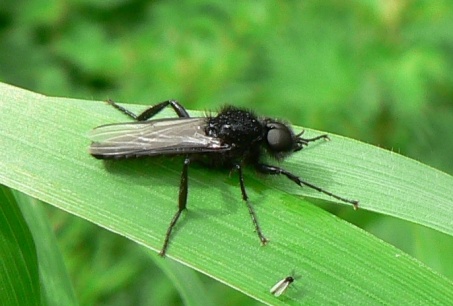
Ramsons
The most
interesting find of the morning on Brook Meadow was a
clump of Ramsons (Allium ursinum)
flowering close to the path towards the north-east
corner of the meadow. This is an attractive plant with
clusters of white star-shaped flowers and long broad
leaves, not unlike Lily of the Valley. In fact, that
is what I thought it was when I first set eyes on it,
but its strong garlic smell gave it away. Grid Ref: SU
75104 06251.
This is the first time
I have seen Ramsons on Brook Meadow. I usually
associate it with woodland where it can be abundant,
though I gather it is not uncommon on river banks and
wet meadows. Interestingly, the grasses around the
plant had been cut away and marker stick placed next
to it. I will check with the conservation group to see
if they know anything about it.
As for the plant
itself, I have no idea how it got there, but I suspect
it may have been planted or maybe sown from seeds.
Ramsons is a native plant and the habitat seems OK for
it, so I see no good reason why it should not be left
there to see how it fares in competition with the
local resident plants. Good luck!
Peter
Pond swans
Walking along
the track from Gooseberry Cottage at about 12 noon, I
found both swans at the nest in the reeds with the pen
busily repairing. She got up briefly while I was
there, but I could not see any eggs, though they could
have been hidden.
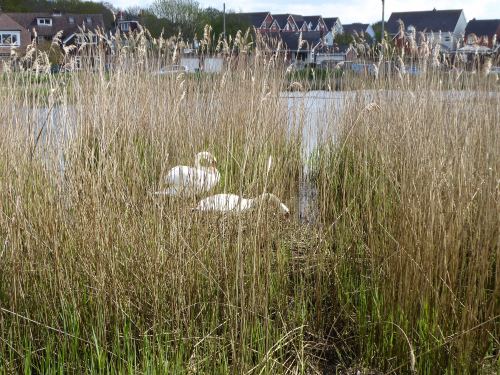
Mallard
family
John Vickers
who lives in the centre of Emsworth near the town
millpond reports that 14 Mallard ducklings hatched in
his neighbour's garden, as they did last year. John's
son Michael managed to get this delightful photo of
the youngsters following their mother down to the
millpond. Keep a look out for them on the pond.
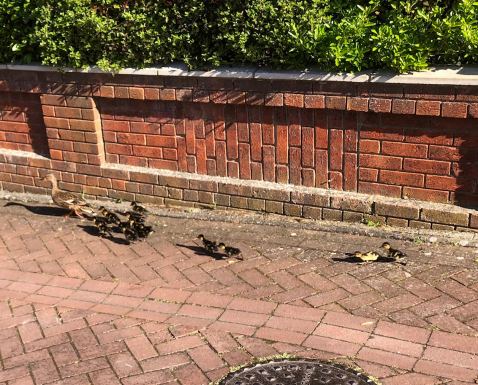
Langstone
Mill Pond
Peter
Milinets-Raby visited Langstone Mill Pond this morning
from 9am to 10:15am - tide out, but slowly coming
in.
Off shore: 2 Greenshank resting, so no ring details. 4
Great Crested Grebes, 1 Shelduck, 4 Whimbrel, 1 Great
Black-backed Gull, There were still about 12+
Oystercatchers, 2 Curlew and 1 Redshank left (another
few weeks and the waders will be gone for a month or
so).
On the pond: A pair of Tufted Duck still lingered.
The Mute Swan pair were re-investing in the nest
behind the mill and when I walked passed later the pen
was sat firmly on the nest again (they had abandoned
it for more than a week).
The best bird of the morning was unusually not seen. A
singing Sedge Warbler was first heard singing
behind the mill in the reed bed there and later by the
island, then by the small bridge. On each occasion it
was keeping out of sight. Almost certainly this bird
is just passing through as none have ever stayed to
breed.
The other great bird of the morning was a Sand
Martin that flew over the pond with two
Swallows.
The Egrets and Herons were as noisy as ever, but there
was no new information to impart. Hopefully a few more
egrets will join as the weather warms up over the next
few days, otherwise it looks like a poor breeding
season for them!
Other birds of note included 2+ Reed Warblers singing,
2+ Chiffchaff singing, 2 Blackcap singing, 4 Stock
Doves, 13+ Med Gulls flying over heading inland (in
ones and twos), a male Kestrel was soaring around the
paddock (which held a Fox) and the usual Cetti's
Warbler was singing its heart out fairly regularly
this morning.
For
the previous month go to . . . April
2018